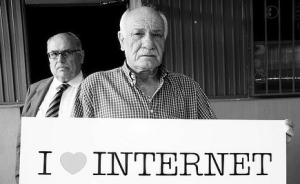Liveblogging Beth Kolko’s presentation on Form, Function and Fiction: ICTs and their uses in resource constrained environments at the Berkman Center. Please excuse misrepresentation, misinterpretation, typos and general stupidity.
The Design for Digital Inclusion group at the University of Washington, which Kolko heads, works on a variety of topics, including tech in Central Asia, the Global Impact Study, the impact of public access to ICTs, technologies for youth with autism, games for development, and more.
Kolko focuses on three main questions: what ICTs are adopted in diverse communities and why? What do people in these communities do with these ICTs? How can we design better technologies for these users?
We assume that ICTs have universal meanings across cultural contexts, but the functions of these technologies vary widely from culture to culture. We need to pay attention to this diversity because designing with it in mind makes systems stronger, less brittle.
Kolko approaches design from both the engineering and humanities perspectives: both form and function. The goal is to blur the boundaries between these two categories until they eventually collapse.
People tend to “get sleepy” when people talk about technology and development, but the findings from the ICT4D field are relevant to a number of communities. Geography is not the primary determiner of resource constraints — the technology developed in, say, Central Asia can be useful in Yakima Valley (in Washington state).
Resource constraints include not just money but also time, cultural capital, screen size, bandwidth.
Kolko’s work in Central Asia has both quantitative and qualitative components, including annual surveys, interviews and usability tests. The survey doesn’t focus on tech use (though it does have a tech use model) — Kolko’s interested in issues of trust, social networks and social institutions as well as technology.
[[Side note: Kolko apologizes for not having a LOLcat photo in her presentation.]]
Internet is weather-dependent: in some places, when it rains, the Internet goes down because rainclouds block satellite access. This intermittent connectivity happens in Central Asia and Cambodia, but also in the rural United States.
Patterns of Internet use (both frequency and duration of access) vary widely across cultures. In Central Asia, most users are online for an hour at a time. There are different pricing structures for chat and actual Internet use (accessing Web pages, etc.).
Mobile phones are particularly key in resource-constrained environments. Mobile phones weren’t created to transfer money, but they’re being used for banking. This, along with general mobile Internet access, brings up questions of mobile phone security. (Moral: if you have an iPhone, use a password.)
Why don’t people use the Internet? It’s too expensive, too hard to access, or too confusing. Also: many Central Asians think it’s “for young people” (though the definition of who’s young depends on who’s answering the question).
Kolko has conducted some design ethnography work focused on the exchange of goods and information via social network in Central Asia. Controlling for demographics, people who use their conventional social networks (face-to-face communication) more are more likely to use technology. These people are also more likely to have higher levels of trust in their friends and family.
Of Central Asian Internet users, more people use the Internet for research for school or job training than for any other purpose. The least common use is for online auctions.
Most Central Asians use their mobile phones several times a day (though only 2% of mobile phones are connected to the Internet). People use their phones not because landlines are particularly expensive or hard to get, but because they want to be able to be reached no matter where they are.
Mobiles aren’t always great: people are already using them for 419-type scams. But their role has been noticeable in the political sphere: after the 2008 revolution in Kyrgyzstan, phones were used to report rioting and looting, both to warn people to stay home and to rally friends and family to help protect businesses. In Kenya, SMS was used to spread rumors and incite violence.
Part of Kolko’s research focuses on games for development. Games are cheaper and, often, easier to use than the Internet. For many Central Asian kids, games provide an first introduction to ICT. This initial training in ICT may give these kids a leg up in terms of later educational and career opportunities.
All of the examples above help provide a better understanding of how ICTs are used in resource-constrained environments. But how to build better ICTs for these regions? You need to focus on design ethnography. For example, looking at how people use mobile phones, how they use their social networks, and the “pain points” of their everyday lives.
Researchers interviewed Central Asians in their homes and had them draw diagrams of their own social networks. Their research lead them to two projects: the Mobile Social Software (MoSoSo) directory addresses the lack of published information directories, working through SMS instead of Internet to list and rate businesses. The Starbus focuses on providing more information about public transportation, using GPS and traffic algorithms to track the location and estimated arrival time of a bus, then send this information via SMS to users who request it.
Interestingly, the initial Starbus design was as low-power as possible to maximize the battery life. They tested the system in Seattle and it worked, but when they brought it to Bishkek they realized that the cell phone towers there required the GPS to have more power. They had to rewire the whole thing — “a classic design approach that failed miserably.”
In order to design the best and most appropriate ICTs, you need to drill deeply to truly define what an “Internet user” is in a particular environment — you can’t assume all Internet users access or use the Internet in the same way.


